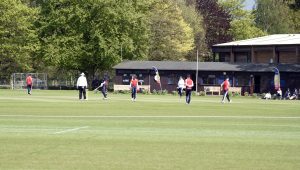A trip back in time to the battlefields of World War I
The trip to the battlefields of World War I was a study tour designed to improve the understanding of 3rd and 4th Form pupils of the issues it involved. However, any visit to Flanders – where there are dozens of cemeteries for the fallen soldiers – is not just historical: it also carries moral dimensions, as the sheer numbers involved becomes clear. Some ten million men died on the western front alone.
The trip visited the main town for British volunteers and conscripts – Ypres. From here, they marched to the frontlines along the Menin Road, and on which is now built the Menin Gate on which the names of 55 000 British and Commonwealth war dead who have no other grave are carved in stone. Among them is C P Maxey, a former pupil of WGS and relative of Will Smithee (see photo of Will, pointing at the name).
The group also visited the largest cemetery for British war dead at Tyne Cot, where Sophie Mosedale (3rd Form) and Will Smithee (4th Form) laid a wreath while the group watched and observed a minute’s silence (see photos). Another ex-WGS pupil’s name is inscribed on the wall at Cot – that of S W W Hercock (see photos) at which Laurence Alecock of 4th Form is pointing.
The idea of the British cemeteries is to make them reminiscent of an English country garden, and so the Arras war graves are planted around with red roses and small flowering plants. Here, pupils were able to wander along the pristine rows of white headstones (see photos) and reflect on the terrible waste of so many young men lost in action. They did this, too, at Langemarck cemetery for the German soldiers (see photos). It contrasts starkly with those built for the British, with its mass graves, black headstones and darkly wooded interior.
The largest memorial is at Thiepval, and pupils briefly stopped here having previously toured the remains of wartime trenches near the Ulster Tower memorial (see photo) and seen the enormous hilltop crater at Lochnagar (see photo) that was created after an underground tunnel was blown up. The museums that have sprung up in recent years were also visited, such as the Flanders Field Museum in Ypres’ Cloth Hall (see photos) and the Passchendaele Museum where artillery shells and gas canisters were presented in the eerie blue light of a cocktail cabinet (see photos).
Pupils got the chance to try out some of the equipment of the era, too, with hard hats worn for the Arras Museum which is based in an underground quarry (see photos of Will Smithee IMG_2597 and Nicole Santuran IMG_2958) and at the Passchendaele Museum (see photo of Kye McEwan, IMG_3175). Perhaps the most breath-taking site, however, was the four-pillared memorial at Vimy Ridge (see photos) where Canadian troops fought with enormous courage against an enemy occupying the high ground.
The trip was both educational and profound, and great thanks must go to Mr Emerson (Head of History) for organising the tour.

